I don’t need to tell you that bed bugs treatment is super expensive.
A new study found that the average bed bug treatment cost for one room rose from $908 in 2022 to $961 in 2023.

And given the current rate of increase, the cost will cross the $1000 mark in 2024.
I had bed bugs when I was broke and I couldn’t afford an exterminator.
But I didn’t give up.
I dug deep into these nasty parasites and found out what bed bugs hate and what kills them.
And in this guide, I’m going to share them with you.
You’ll find proven science-backed DIY methods that I implemented to get rid of bed bugs on a tight budget.
I’ll also share why persistence is the key to eliminating bed bugs.
Keep reading to evict bed bugs from your home and to prevent them from returning.
Alarming Signs of Bed Bugs

These nasty blood-sucking parasites leave behind the signs of their presence.
These signs are the sort of tracks that you need to follow to zero-in on them.
These signs are –
- Adult bed bugs – they look like flat apple seeds. They’re dark brown and oval.
- Bed bug nymphs – Miniature bed bugs that are translucent white or light tan.
- Bed bug eggs – Very difficult to see. They’re mostly inside the crevices or in the seams of bed mattress and in box springs.
- Bed bug shells – The shells are their molted or shed skin.
- Feces – Appear as dark reddish spots on the bed fabric.
- Bed bug bites – Itchy red lumps that appear in clusters or in straight line on the skin
Where to Vigilantly Check for Bed Bugs
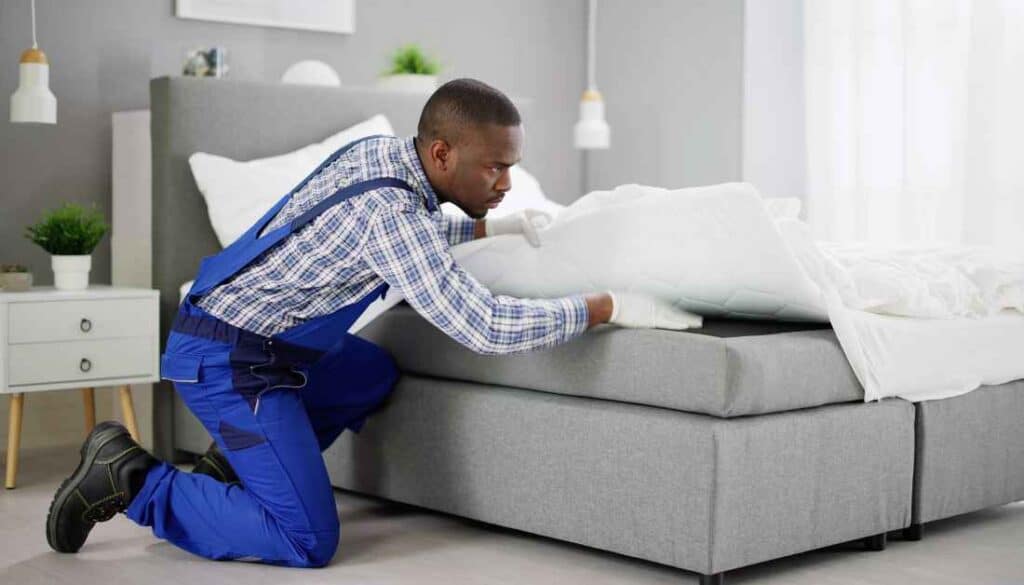
Bed bugs hide in any crevice within 6-8 feet radius from the bed.
But they can spread out when their numbers increase or when the infestation worsens.
Here are the common places where bed bugs hide –
- Examine the stitching and clusters of the mattress and box spring.
- Close to the edge or label on the mattress and box spring.
- Fissures and gaps in the headboard, footboard, and bed frame.
- Connections (crevices) of drawers and additional bedside furniture.
- Stitching of sofas or seats in the room.
- Behind electrical receptacles on the wall.
- Scrutinize wall decorations and picture frames.
- Folds of drapes.
- Interior of electrical devices like a timepiece or docking station.
- Investigate where the rug meets the wall.
- Examine behind baseboards and other molding pieces.
In these areas you’ll find bed bugs and their signs.
One hack that worked amazingly well for me is by inserting credit card inside the crevices.
When I slowly pulled it out of the crevices, I found bed bug shells, egg casings, and even bed bug nymphs on it.
I inspected my room for bed bugs during the day for better visibility and thorough inspection of every corner of my living space.
Cheap Products You’ll Need to Get Rid of Bed Bugs
You’ll need some equipment, insecticide sprays, and bed bug traps to eliminate bed bugs.
Here’s what I used. I recommend that you buy them before proceeding.
[Crossfire Bed Bug Concentrate – Average Price: $48.95]
I tried a lot of insecticides to kill bed bugs. But they had no effect.
I searched the web and found that bed bugs are immune to pyrethrin and pyrethroid-based insecticides.
To my shock, I realized that all the insecticides I was using contained these compounds.
So, I reached out to a pest controller just to ask which insecticide to use for DIY bed bug treatment.
He recommended Crossfire bed bug concentrate.
Crossfire contains Clothianidin, which gives it a longer residual toxicity than most of the bed bug insecticides.
And it also contains metofluthrin and piperonyl butoxide that kill bed bugs by breaking down their immunity.
[1 Gallon Insecticide Sprayer – Average Price: $15]
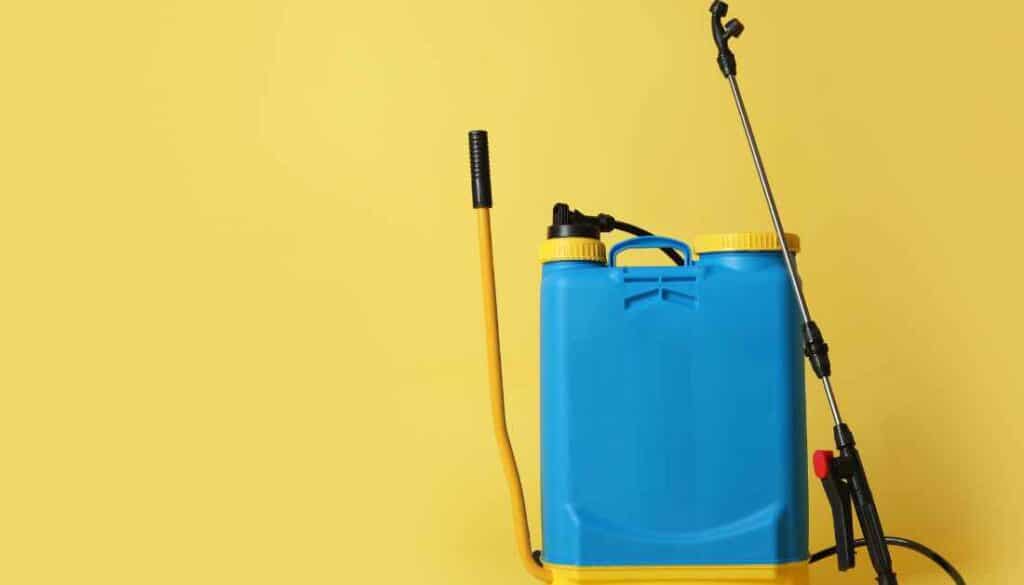
You’ll need to mix water with the concentrate to make the spray out of it.
So, for spraying, you’ll need an insecticide sprayer.
[Bed Bug Interceptors – Average Price for a Pack of 12: $34.99]

These are bed bug sticky traps. You’ll need to keep them below the bed’s legs.
Bed bug traps or interceptors are indispensable for monitoring bed bug activity after treatment.
[Diatomaceous Earth – Average Price: $20]
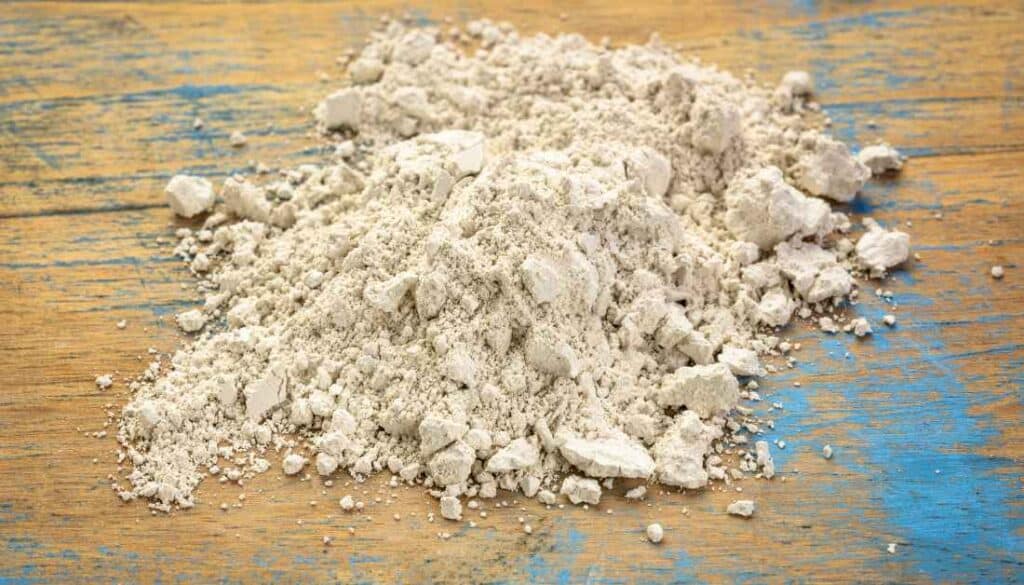
Diatomaceous earth is a natural insect killer. It’s desiccant dust.
It penetrates the exoskeletons of bed bugs and kills them by triggering dehydration from the inside.
It’s not an instant bed bug killer.
But it’s highly useful to kill and repel bed bugs.
[Silicone-based Sealant – Average Price: $10]

You’ll need a sealant to seal the gaps and cracks where bed bugs hide.
[Sealable Plastic Bags – Average Price of a Pack of 100: $25 ]
You’ll need plastic bags that you can seal to keep the infected items.
These bags will play a vital role in treating and disposing of the bed bug-infested items.
[Mattress Encasement: Average Price for a Queen Size Bed: $55]

You’ll need more than one treatment to eliminate bed bugs.
And till bed bugs are completely gone, you’ll need the encasements to prevent bed bug bites and re-infestation in the mattress.
[Nuvon Bed Bug Strips – Average Price for a Pack of 12: $51]
You’ll need these strips to treat infected items in sealed plastic bags.
There are two other things that you’ll need to kill and remove bed bugs – vacuum cleaner and steam cleaner.
As most people have these cleaners, I didn’t mention them.
The total cost of these items is $259.94.
But keep in mind that the treatment cost can increase depending on the size of the house.
Fail-Proof DIY Bed Bug Removal Plan

Without a thorough plan, you’ll fail. I failed too.
I was randomly using insecticides. And bed bugs were coming back.
So, after a lot of trial and error, I found the following plan worked remarkably well.
- Decluttering.
- Isolating infected items.
- Washing fabrics in hot soapy water.
- Heat treatment.
- Spraying insecticide and desiccant dust.
- Vacuum cleaning.
- Treating infected items.
- Sealing.
- Tracking.
- Repeating.
Now let’s follow the plan to the T, without skipping any steps.
Ruthlessly Declutter Your Room
Bed bugs love clutter. It provides them with the hiding places they need.
Also, a highly cluttered room makes treatment impossible.
Clutter prevents desiccant dust and insecticide spray from reaching the bed bugs.
So, dispose of all the useless items.
Put them in sealed plastic bags.
And contact your garbage disposal company to dispose of them safely.
Move all the furniture and heavy items 2 feet away from the walls to create space.
I referred to this excellent animated resource on how to prepare your room for bed bugs.
You can refer to it. I found it really helpful.
Wisely Isolate Infected Items
Put small items such as books, bed fabrics, clothes, toys, etc. in sealed plastic bags.
They can contain bed bugs.
Do not take them out of the room without putting them into sealed bags.
If you do, then bed bugs can spread to other rooms.
Wash Fabrics in Hot Water
Wash fabric items like bed sheets, pillow covers, clothes, etc. in hot, soapy water.
Remember to carry them to the washing machine in sealed plastic bags.
And then, dry those fabrics in high heat.
Hot soapy water and heat kills bed bugs in all lifecycle stages.
So, by washing them, you’ll kill not only adult bed bugs but also their eggs, nymphs, and instars.
Bed Bug Heat Treatment With Steam Cleaner

Now the fun begins. It’s time to kill bed bugs with heat.
Heat is an instant bed bug killer. Pros use their heating machines to smoke the bed bugs.
But you have your own steam cleaner to do it.
I’d recommend buying one if you don’t have one.
Bed bugs die if you expose them to temperature between 135°F (57.2°C) and 145°F (62.7 °C).
So, set the heat of your steam cleaner at the appropriate heat range.
And use the steam cleaner to clean the bed mattress, couch, carpet, and other soft furnishing.
I was very slow and methodical while steam cleaning.
It ensured that I didn’t skip any edges or corners and the labels and felt clothes.
And I was pleasantly shocked to see so many dead bed bugs because of the heat.
I cleaned the room with my steam cleaner thrice to be safe.
But I didn’t stop.
I knew for sure that there were many more bed bugs hiding.
After all a steam cleaner’s heat can’t penetrate the cracks on the headboard, baseboard, furniture, and floor.
So, it was time for insecticide treatment.
Insecticide Bed Bug Treatment
Pour the Crossfire concentrate in the sprayer. Add water to it.
Mix it well.
And then use the sprayer to spray the insecticide in the cracks and crevices in the room.
Spray it on the bed’s headboard, storage, and on the bed frame.
But do not spray on the bed mattress.
Crossfire has a high residual toxicity, which can be risky for you.
If you spray it on the mattress, then the insecticide will remain on it for at least two weeks.
Remove the bed mattress before spraying the insecticide on the bed’s hardware.
Remember, the key here is not to skip any gap no matter where it is.
I turned off the power of the entire house by flipping off the main breaker.
Why?
Because I had bed bugs even hiding in the electrical receptacles.
And using a liquid spray in them can electrocute me.
The insecticide has a strong residual toxicity.
So, wait for a couple of hours before proceeding to the next step.
One critical mistake I made while using insecticide spray.
I used the wrong nozzle.

Choosing the correct nozzle is crucial. It helps the insecticide spray to reach into the thinnest of crevices.
I was using the fan spray nozzle that produced a wide spray pattern.
It failed to reach inside the cracks.
So, I switched to pin stream nozzle.
It helps the insecticide to reach into cracks and other hard-to-reach areas where bed bugs can hide.
However, I kept the fan spray nozzle to treat the wider areas such as floors and carpets.
Scatter Diatomaceous Earth
Bed bugs are resilient.
Plus, they’re experts in escaping.
Their flat bodies enable them to hide deeper into the thinnest of gaps and holes.
Some might have escaped the insecticide and heat treatment in the previous steps.
So, I scattered diatomaceous earth in the room, couches, and on the bed mattress.
It’s not an instant bed bug killer. So, I waited for 30 minutes to let it do its work.
Vacuum Cleaning
Take your vacuum cleaner and give your room a thorough cleaning.
Clean every nook and corner of your room, bed, and furniture while cleaning.
The area where the carpet meets the wall is a place where bed bugs can hide. And many people skip it.
So, don’t skip the edges of the room’s floor and baseboards.
Treating Infected Items
Remember in the second step I talked about treating infected items in sealed plastic bags.
You can easily do it by using pesticide strips.
I used Nuvon pro strips that contain Dichlorvos or DDVP that kill bed bugs in small confined spaces.
Keep these strips in bags containing electronic items, books, and other useful items.
I kept the strips for three days to let them do their work.
The vapors from the strips killed the bed bugs hidden in the infested items.
Freezing temperature also kill bed bugs.
If you don’t want to use the strips, then keep the sealed plastic bags inside in the freezer for three days.
But I’d not recommend keeping electronic items inside the freezer.
It’d be best to use pesticide strips in plastic bags containing electronic items.
Sealing Cracks
Sealing the gaps and crevices in the room eliminates the bed bugs’ hiding places.
I used a silicone-based sealant to caulk the gaps on the floor, walls, furniture, and bed.
Silicone and polyurethane-based sealants are tough. And bugs can’t chew through them.
Also, I didn’t stick the furniture, especially my bed, with the walls.
It’s because bed bugs on the walls can end up in them.
Tracking And Monitoring Bed Bugs
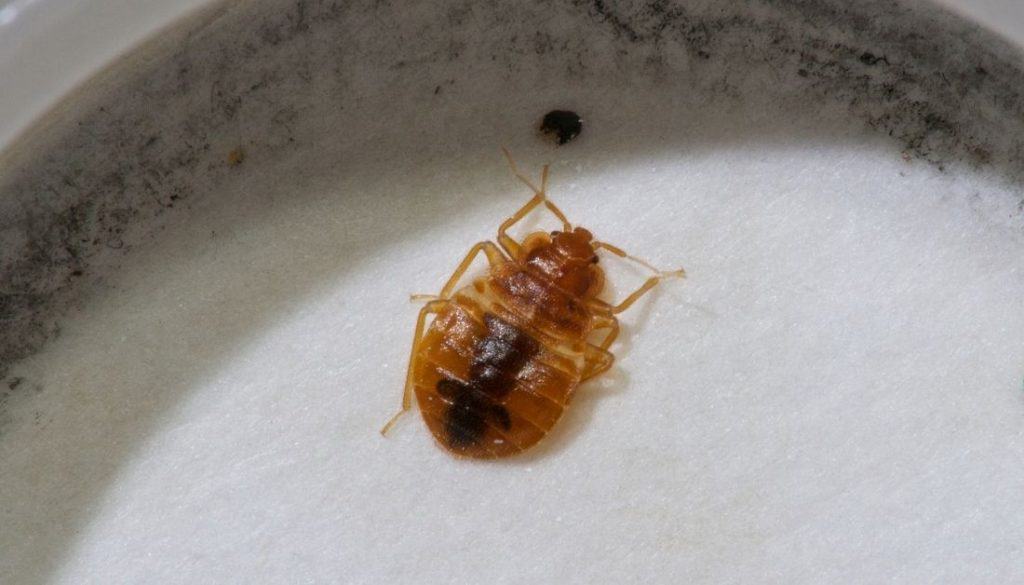
Now comes the shocker.
There will be bed bugs in the house/room despite all the treatment.
And it’s common to see bed bugs returning after a single treatment.
Heck, bed bugs can return even after three to four treatments.
The worst part is that many people see bed bugs returning even a year after the treatment.
Their mistake?
They didn’t monitor their home for bed bugs.
Regular visual inspection and bed bug interceptors are vital for monitoring the home for bed bug activity.
Daily inspect the areas where you’ve found bed bugs before the treatment.
Also, keep bed bug interceptors under each leg of the bed.
These interceptors have a sticky surface.
When the bed bugs want to climb the bed from the bed’s legs, they get stuck in the trap.
Repeating The Treatment
Bed bug removal needs multiple treatments.
Even pros do it.
Professionals always revisit your home to check for bed bugs and their signs after the treatment.
On seeing any, they use insecticide sprays or heat, again, depending on how many bed bugs they’re seeing.
That’s why bed bug treatments are so expensive.
So, if you’re seeing bed bugs or their signs, then repeat the process.
Do it till you don’t see bed bugs.
I treated every room of my house, twice a week, for 7 months, till I stopped noticing bed bugs and their signs.
Yes, it’s a tough ask.
But that’s the only way to ensure that your home has no bed bugs if you can’t afford an exterminator.
Preventing Bed Bugs In The House

Elimination is one aspect of bed bug control.
Another aspect, which is equally vital, is bed bug prevention.
And you can do it in several ways.
Geraniol Oil
A recent research study in 2021 showed that bed bugs stayed away from areas treated with geraniol, eugenol, citronellic acid, and carvacrol.
The shocking part is that peppermint and cedar oil didn’t repel bed bugs!
So, I mixed 7 drops of geraniol oil in water and used it as a spray in the room and on my bed.
And it kept bed bugs away.
Mattress Encasements
Mattress encasements are a lifesaver when it comes to preventing bed bug bites.
It acts like a barrier between the skin and bed mattress.
So, if there are any bed bugs still surviving in the mattress, they won’t be able to bite.
Those bed bugs will also die due to asphyxiation.
Regular Cleaning
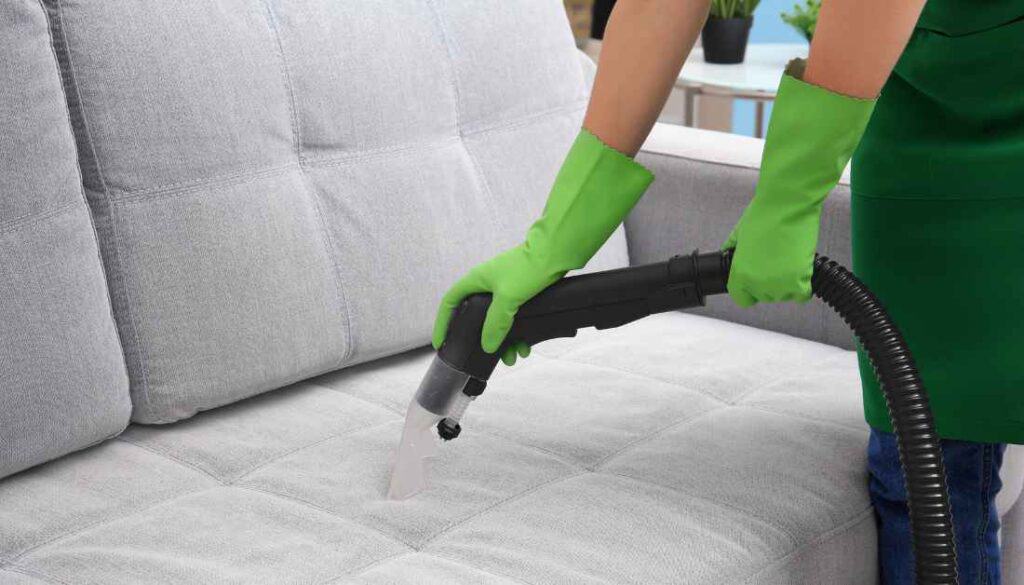
Daily vacuum cleaning of the house is also essential to prevent bed bugs.
Cleaning the soft furnishing such as carpets and upholstery will remove any bed bugs hiding in them.
And it’ll also prevent re-infestation.
Reduce Clutter
Clutter in the room provides bed bugs living spaces. Don’t give it to them.
Ensure that your room always has breathing space.
A room without clutter is always easy to clean and to apply bed bug treatments.
Inspecting Second-Hand Furniture
Second-hand furniture, including carpets, can contain bed bugs.
Inspecting them for bed bugs before bringing them home helps in preventing bed bug infestations.
Being Wary of Bed Bugs In Hotels
Hotel rooms can have bed bugs. Check for any history of bed bug infestation of a hotel before booking a room in it.
Inspect the hotel room for bed bugs by checking for their signs in the bed mattress and storage sections.
And when you’re back, immediately wash all the fabrics in hot water before restocking them your closet.
Bed bugs spread by hitchhiking. They latch onto things like luggage, furniture, books, and clothes to travel to your home.
Consider Buying Portable Heat Boxes
This is an optional step if you can afford it.
Portable heat chambers are effective in killing bed bugs in infested items.
Be sure to read the instructions on these boxes before using it. And keep in mind that EPA and Federal agencies don’t regulate.
I’m recommending it because it has worked very well for me.
Precautions to Take While Killing Bed Bugs
DIY bed bug treatment exposes you to insecticides and heat.
Both can have negative effects if you’re not careful.
So, I highly recommend that you read the safety instructions before handling chemicals.
And always wear PPE (personal protective equipment) such as shoes, gloves, and masks during the treatment.
Also, ensure that no item from the infected room goes to another room.
FAQs
How Do I Know If I Have Bed Bugs?
There are many bugs in bed that look like bed bugs.
And many people panic when they see bed bug look-alikes.
So, identification is critical.
Take a pic of the bed bug and ask experts in forums like r/bedbugs in reddit.
You can also ask a pest controller or someone who has suffered from bed bugs.
When Can I Put Things Back In The Room After Treatment?
If you’ve treated everything in the room for bed bugs, then you can restock the room immediately after the treatment.
However, if you haven’t, then don’t.
First treat all the items that were in the room. And then put them back only after you’ve treated the entire room.
Will Bed Bugs Die in an Empty House?
Bed bugs can remain active in an empty house for six to nine months.
In the absence of hosts, they don’t get bloodmeals. And when they don’t feed, they can’t breed.
Where To Sleep If I Have Bed Bugs?
Do not change the sleeping room. If you do, bed bugs will follow you to other rooms to get their bloodmeals.
That’s also one of the ways bed bugs spread from one room to another.
Use the repellents I mentioned and mattress encasements to prevent bed bug bites.
Also, vacuum clean or steam the bed with a steam cleaner before going to bed.
Why Am I Seeing Dead Bugs After Treatment?
The residual toxicity of the insecticide works even after treatment.
It kills the bed bugs that make contact with surfaces that have insecticide.
So, you see dead bed bugs even days after treatment.
Recap
Remember, DIY bed bug removal and prevention needs patience and perseverance.
On top of that, you’ll need to use the right treatment items to kill and prevent bed bugs.
I’ve done the heavy lifting for you.
I shared how you can use a mix of natural and chemical treatment to get rid of bed bugs if you can’t afford professional treatment.
I’m 100% sure that the steps I laid out will help you to get rid of bed bugs if you’re on a tight budget.
You don’t need to suffer from bed bugs like I did.
Roll up your sleeves and get going.
And share the results in the comments sections below.
References:
- González-Morales MA, Terán M, Romero A. Behavioral Responses of the Common Bed Bug to Essential Oil Constituents. Insects. 2021 Feb 21;12(2):184. doi: 10.3390/insects12020184. PMID: 33670065; PMCID: PMC7926421.
- Environmental Protection Agency, Do it Yourself Bed Bug Treatment
- Romero A, Potter MF, Haynes KF. Behavioral responses of the bed bug to insecticide residues. J Med Entomol. 2009 Jan;46(1):51-7. doi: 10.1603/033.046.0107. PMID: 19198517.
- Virginia Tech, Non- Chemical Bed Bug Treatment
- State of Bed Bug Market Report, 2023.
- Proceedings of the National Academy of Sciences of the United States of America, Uncovering the Hidden Costs of Bed Bugs


